The Basilica di Santa Croce (Church of the Holy Cross) was built in the late thirteenth century in the Florentine Gothic style. The church is known as the ‘Pantheon of Florence’ since it contains the tombs of many illustrious Italians.
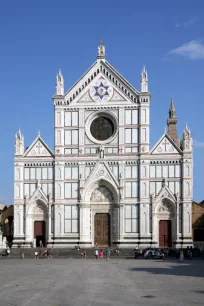

The church was, together with the Duomo and the Santa Maria Novella, one of three major churches that were at the time being built by the city of Florence. All three feature similar marble patterned facades designed in typical Florentine style.
History
Construction of the church started in 1295 on a site near the Arno river where Franciscan friars had built a small oratory. According to Vasari, the church was designed by Arnolfo di Cambio, a Florentine sculptor and architect who also drew up the plans for the cathedral and the old palace. The church was consecrated in 1443 by pope Eugene IV.
In 1512 the bell tower was destroyed by lightning, and it was only replaced in 1847 by a new Neo-Gothic tower designed by Gaetano Baccani. The marble facade, by Nicola Matas, was added even later, between 1853 and 1863. Funds for its construction were provided by Francis Joseph Sloane, a wealthy British citizen.
Church and cloisters
Santa Croce has a wide nave supported by pointed arches. Upon entering, the visitor’s attention is attracted by the Chapel of the High Altar at the end of the nave. It is decorated with frescoes created by Agnolo Gaddi. They depict the story of the True Cross. Light pierces through the stained-glass lancet windows, which were also the work of Agnolo Gaddi.
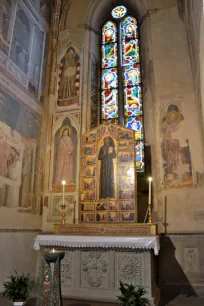
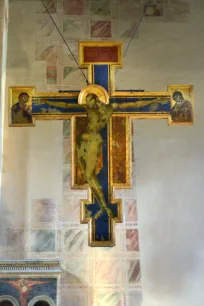
To the right are the Bardi and Peruzzo Chapels. Both were painted by Giotto, the Bardi Chapel in 1315-1320 and the Peruzzi Chapel in 1320-1325. Frescoes on the walls of the Bardi Chapel depict scenes from the life of St. Francis, and in the Peruzzi Chapel you can see scenes from the lives of St. John the Baptist and St. John the Apostle. The frescoes were overpainted in the eighteenth century, apparently because they distracted the churchgoers, but they were restored in 1959.
Another Bardi Chapel, in the north transept, holds a wooden crucifix created by Donatello. His friend Brunelleschi thought Donatello made Jesus look like a buffoon, so he wanted to show he could do better and created a crucifix himself, which is now in the Santa Maria Novella. Donatello’s work, created in 1425, is nonetheless very realistic and expressive.
The painted crucifix by Cimabue is even more famous. The large painting, executed in 1265 on a wood panel measuring 4.48 by 3.9 meters, is one of the first realistic depictions of the crucifixion. Unfortunately, it was almost completely submerged in water during the flood of the Arno river in 1966. It was irreparably damaged and despite renovations it is still in a terrible state.

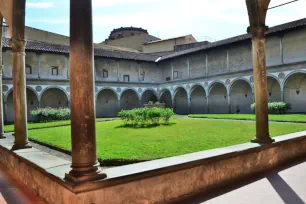
The crucifix hangs in the refectory, which can be accessed from the main cloister. On the east side, the cloister gives access to the Chapter House, better known as the Pazzi Chapel. It is named after its patron, Andrea de’ Pazzi. The chapel was designed in 1429 by Brunelleschi, but construction only started in 1443, and it was completed in 1466, long after Brunelleschi’s death. The chapel is considered a masterpiece of Renaissance architecture. It is subtly decorated, not with frescoes, but with tondos in glazed terracotta created by Luca della Robbia.
On the east side is the sacristy, which can be accessed from the south transept. This room is magnificently decorated with authentic furniture and frescoes from the mid-fourteenth century; no space is left undecorated. The sacristy holds the church’s most important relic: a piece of wood supposedly from the Holy Cross, after which the church is named.
Santa Croce has a total of three cloisters. The aforementioned main cloister was designed by Arnolfo di Cambio. Towards the south is the second and smaller cloister, designed by Brunelleschi. This arcaded cloister is considered one of Florence’s most beautiful cloisters. There’s a third, even smaller cloister that dates from the thirteenth century and which formed the heart of the original Franciscan building.
Tombs
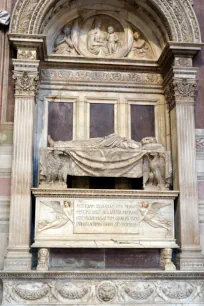
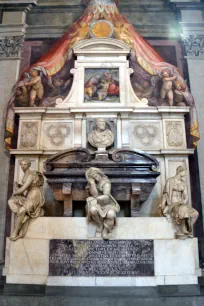

Santa Croce is the last resting place for many famous Italians. Not only are there numerous tomb slabs in the pavement, but plenty of funerary monuments line the walls of the church.
It is only appropriate that this church in Florence, the birthplace of Renaissance, holds what is considered the first Renaissance funerary monument: the tomb of the politician Leonardo Bruni, created in 1444 by Bernardo Rossellino. It served as an example for many other funerary monuments, such as the tomb of Carlo Marsuppini, situated against the north wall.
The most famous sepulchral monument in Santa Croce is the first on the south wall, which contains the remains of Michelangelo Buonarroti. It was designed by Giorgio Vasari and shows Michelangelo’s bust flanked by the mourning allegorical figures of Painting, Architecture and Sculpture. The statues were created by Giovan Battista Lorenzi and Valerio Cioli.
Michelangelo died in 1564 in Rome, where a tomb was built for the artist in the Church of the Twelve Holy Apostles. Michelangelo however had indicated he wanted to be buried in his native Florence, so with the approval of the duke of Florence, his nephew Leonardo Buonarroti stole the artist’s body and transported it to Florence. An inscription on a panel at the bottom of the monument recounts the story.
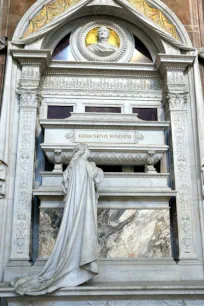
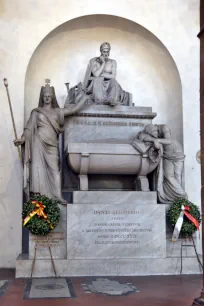
Opposite Michelangelo’s tomb sits the tomb of Galileo Galilei. Galileo died in 1642, but as a result of his condemnation by the Church in 1633 he wasn’t allowed a Christian burial until 1737, when his body was buried here. His funerary monument was designed by Giovanni Battista Foggini, who also created the central bust of Galileo, who can be seen gazing towards the stars. The allegorical statue of Astronomy on the left was created by Foggini’s son Vincenzo. The statue on the right, representing Geometry, was executed by Girolamo Ticciati.
Another famous person buried in Santa Croce is Gioacchino Rossini, one of Italy’s greatest composers, best known for his opera ‘The Barber of Seville’. Rossini died in 1868 in Paris and was buried in the cemetery of Père-Lachaise. Nine years later, his body was exhumed and transferred to Santa Croce. He lies buried in a sepulchral monument created by Giuseppe Cassioli that shows a muse mourning by Rossini’s tomb.
The Italian poet Dante Alighieri is buried in his native Ravenna but is remembered here with a cenotaph, set against the south wall near Michelangelo’s tomb. The cenotaph was created in 1829 by Stefano Ricci and shows a pensive Dante atop his empty tomb, flanked by the allegorical figures of Italy and Poetry.
There are several more sepulchral monuments in the church, including the tombs of Ugo Foscolo (a writer and poet), Niccolò Machiavelli (a historian and diplomat whose book ‘Il principe’ led to the term Machiavellianism) and Vittorio Alfieri (a poet and dramatist). Marie-Julie Clary, wife of Joseph Napoleon, is also buried here, in the Bonaparte Chapel, together with their daughter Charlotte.

